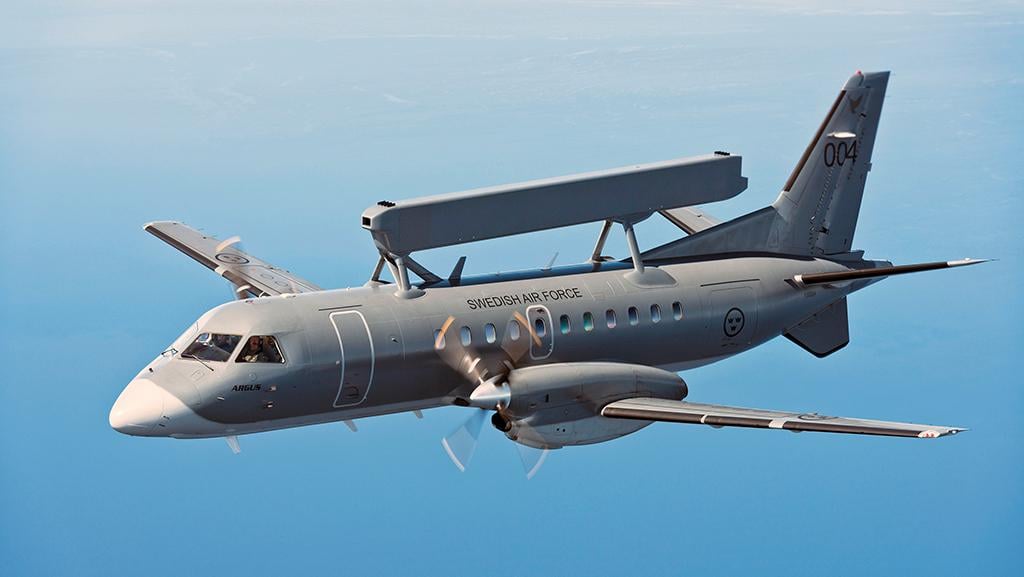
Sweden is sending Ukraine a pair of Erieye-radar-equipped Saab 340-based ASC 890s, a platform that would be a high-value target to the Russians.
Sweden’s decision to provide Ukraine with an airborne early warning capability could provide Kyiv with a tangible advantage in its effort to rebuild air supremacy over the battlefield.
Stockholm is donating its remaining pair of long-serving ASC 890 airborne early warning (AEW) aircraft, a platform based on the Saab 340 regional airliner and equipped with an Erieye active, electronically scanned array radar. The move aims to bolster Ukraine’s air defenses and complement a soon-to-be-delivered Lockheed Martin F-16 combat aircraft fleet. The ASC 890s will give Ukraine’s air defenses an all-seeing eye across the theater, provide timely information about incoming air attacks and transmit situational data to the F-16s via Link 16.
The ASC 890s come as part of a 13.3 billion Swedish krona ($1.26 billion) equipment donation equivalent to around 10% of Stockholm’s annual defense spend. The donation is part of a growing effort by European countries to bolster Ukraine’s defenses after several torrid weeks.
Earlier in May, Russia opened a new front in the war, and thousands of troops crossed the border near the Ukrainian city of Kharkiv. Ukraine has blunted the Russian offensive, but the effort required moving troops from elsewhere.
- Swedish airborne early warning aircraft part of $1.26 billion donation package
- Stockholm to purchase three Saab GlobalEyes
- ASC 890s will be able to provide Link 16 data to F-16s
- Sweden remains committed to providing Gripen fighters
In addition to the AEW aircraft, the Netherlands is leading an initiative encouraging Europe’s Patriot system users to pool spare elements into a single battery to add to those already delivered by Germany and the U.S. Belgium also has declared it will deliver 30 F-16s to Ukraine, adding to the more than 50 Denmark and the Netherlands have pledged. Although Brussels had announced the F-16 transfers, it had not previously said how many.
“Sweden is now making it very clear that we will do what is necessary for Ukraine to win this war,” Sweden’s Deputy Prime Minister Ebba Busch said in announcing the latest equipment package on May 29.
No timelines have been revealed for delivery of the ASC 890s, but as Ukraine has never had such a capability before, the country’s crews will need “considerable training” to get the most out of the system, says Douglas Barrie, senior fellow for military aerospace at the London-based International Institute for Strategic Studies.
In addition to their aerial surveillance tasks, the ASC 890s could also be used for ground and sea monitoring. Some Erieye radar models are equipped with ground moving target indication and overwater surveillance modes, although it is unclear whether Ukraine’s aircraft will have these capabilities. The ASC 890s do have the ability to pass information over the Link 16 data link, resolving questions over whether the Ukrainian F-16s would have such access to support their operations. Sweden is understood to have installed the capability when leasing ASC 890s to other customers, modifications which enabled the country to commit the aircraft to multinational operations with NATO before joining the alliance.
“These will become high-value assets, particularly in the eyes of the Russians,” Barrie says. “Ukraine will have to weigh the risk of how to use them and how to protect them.”
Ukraine has already downed one of Russia’s valued Beriev A-50 AEW aircraft and claims to have taken out a second using its ground-based air defense systems. That effort has pushed Russian operating orbits back from Ukrainian airspace and reduced their effectiveness. There appears be an active Ukrainian campaign to strike Russian air assets and air defense systems ahead of the F-16s’ arrival.
The transfer of the ASC 890s “deepens . . . cooperation within the air domain,” states a security cooperation agreement between Sweden and Ukraine signed May 31. Sweden still wants to transfer Saab Gripen fighters to Ukraine at an “appropriate point in time,” the document says.
Defense Minister Pal Jonson earlier told Swedish media outlets that Stockholm was asked to pause its Gripen donation so Kyiv could focus on introducing the F-16.
Ukraine remains on course to receive its first F-16s this summer, with training of aircrew and engineers at an advanced stage in several European countries and in the U.S. Information on their potential armaments remains limited, although they are likely to be equipped with the AIM-120 Amraam, given that the same weapon is already being used in the ground-based Kongsberg-Raytheon Nasams air defense system provided by Norway and the U.S.
Transferring the ASC 890s will leave a gap in Sweden’s defense capability, which will be filled by the accelerated introduction of the Bombardier Global business jet-based Saab GlobalEye AEW platform. Stockholm originally had two GlobalEyes on order but is now increasing this to three, reflecting the new regional security situation.





